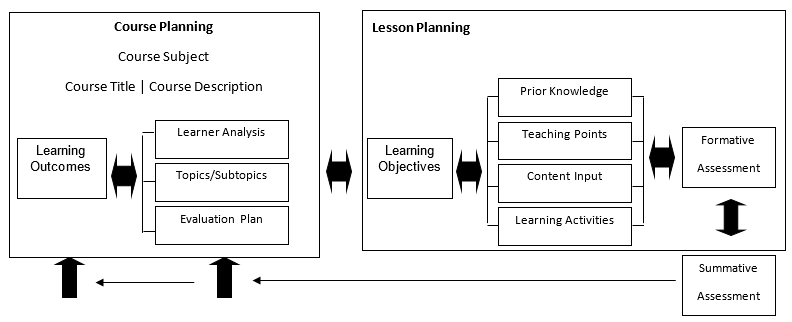Lesson planning
A lesson plan is a description of the sequence of activities engaged in by both the instructor and the learners in order to achieve the desired objectives together with a schedule for the lesson and a list of instructional resources. As the instructor it is important to consider the three basic elements when planning a lesson; the introduction (bridge-in, objectives, pre-assessment), the body (participatory learning) and the conclusion (post-assessment and summary).
- Bridge: What do you do to get students’ attention or create interest in your topic?
- Objectives: How do you determine what students should be able to do by the end of the learning unit? How do you convey this?
- Pre-assessment: How do you determine what students already know or are able to do?
- Participatory learning: How do you present information/ideas/concepts in an engaging way? What do you do to help students process and learn?
- Post-assessment: How do you determine the degree to which your objectives have been achieved?
- Summary: How do you link learning to assessment? How do you link course learning to program and professional goals?
About lesson planning and instruction
Lesson planning goes beyond selecting appropriate content for a specific lesson; it involves considering learning goals, selecting appropriate learning activities, and assessing whether learning has been successful. Below are some resources that will assist with the planning process.
Instruction guides learners in working with information (i.e. finding it, organizing it, applying it, evaluating it, synthesizing it). Planning instruction often follows the process below, but in reality it can begin at any point and expand to include the other elements. Information is not instruction (Merrill, 1997).
Instruction leads students in applying, evaluating, or synthesizing knowledge, skills, and/or attitudes through learning activities. Instruction is most effective when it:
- Moves learners towards clearly defined learning outcomes and objectives at all levels of Bloom’s Taxonomy
- Includes a variety of groupings, motivational techniques, ways of determining prior knowledge, content input strategies, learning activities, practice exercises, and assessment methods
- Offers feedback to both students and the teacher regarding learning.
- What strategies could be used to increase variety in your instruction?
- How is each instructional activity linked to learning outcomes and objectives?
- How do learning activities need to be structured in your subject area to lead students to apply, evaluate, or synthesize key information?
Consider identifying strategies that you already use or those you might add to your list of instructional techniques.
About scaffolding
Based on research, an important aspect of instruction is building structures or networks that support learning in a particular discipline. Scaffolding resources are designed to provide “intellectual support for students’ thinking until they learn how to handle the subject matter more independently” (Indiana State University).
Scaffolding resources provide structure to help learners with the following:
- Organizing and processing information
- Working through a thinking and/or problem-solving process
- Following procedures
- Completing tasks
- Developing skills
Scaffolding develops confidence with thinking and process structures. Those structures need to provide a solid framework without being a straight jacket for creativity. This is the balancing act – Scaffolding must support, but not limit the “construction” process. Click the button below to access more comprehensive information about scaffolding, including ideas for classroom implementation and additional resources.

- As an expert in your discipline, what processes and frameworks do you use for organizing, thinking about, and communicating information and ideas? How can you make those processes and frameworks more explicit for your learners?
- In your course or discipline, what aspects of learning (i.e. knowledge, skills) pose consistent difficulty for students? What resources could provide support and structure in those areas?
- Frameworks
- Experts use frameworks in their disciplines intuitively (i.e. scientific method, problem solving, design processes, planning frameworks).
- Making frameworks explicit allows learners to spend more time working with the content.
- Visit the link below for a sample Problem Solving Framework.
- Charts and other visual organizers
- Charts and other visual organizers (i.e. timelines, Venn diagrams, trees, flow charts, outlines, storyboards, tables, graphs, diagrams) provide clear structures for extracting, organizing, and processing information.
- Step-by-step process guides
- Breaking complex tasks into steps provides the structure many students need to get started on and complete a learning task successfully.
- Such guides encourage faculty to articulate how they, as experts, work through the task.
- Visit the link for a guide for developing and supporting an argument.
- Tip sheets (step-by-step skill guides)
- As experts in our discipline we naturally do things that required many repetitions in the learning stages.
- Tip sheets allow learners to review and practice skills independently as many times as necessary.
- Visit the link below for a sample Tip Sheet on Evaluating Information Sources.
- Guiding questions (i.e. reading guides, lecture guides, video guides)
- Guiding questions help learners focus their attention and act as a filter for large amounts of information.
- Visit the link below for Pedagoggle on facilitating learning with effective questions.
- Informational resources
- We don’t generally have time to teach students all the skills they need to effectively complete assignments. However, we can provide them with supporting informational resources for reference.
- Visit the link below for a sample informational resource on Annotating Text.
- Self-assessment and peer assessment guides
- Self- or peer assessments are generally only effective when students have clear structures and guidelines that help focus their attention, and give them the language they need to give constructive feedback.
References
Merrill, M.D. (1997). Instructional strategies that teach.CBT Solutions, Nov./Dec., 1–11.
